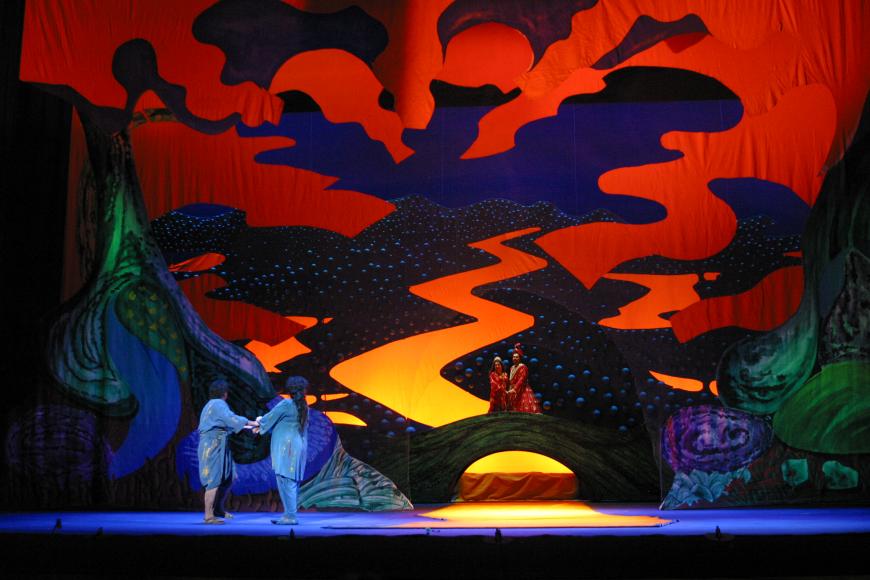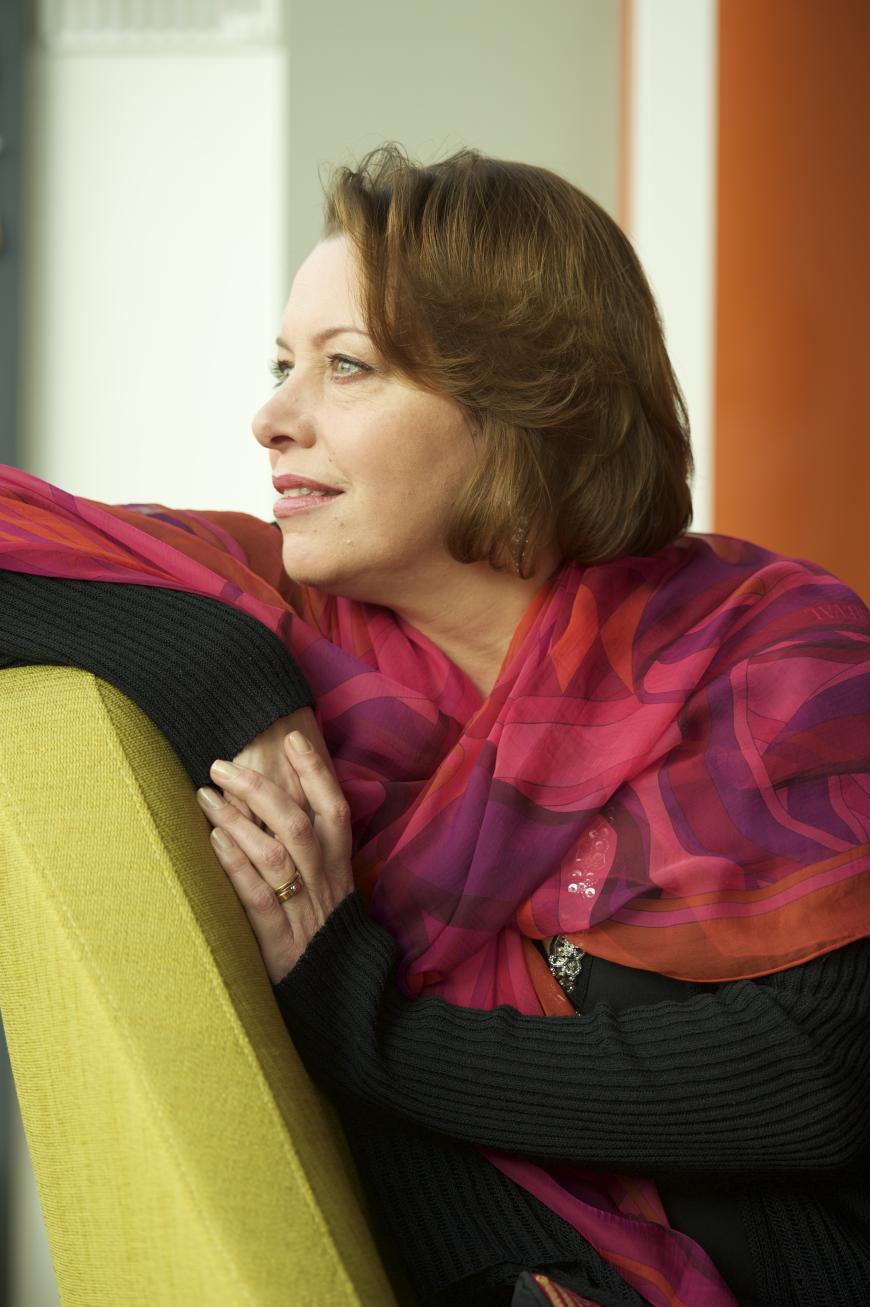
Musically magnificent, theatrically complex, confusing, and controversial, with impossible production and cast demands, Richard Strauss’s 1919 Die Frau ohne Schatten (The woman without a shadow) had to wait 40 years before its American premiere.
When that finally happened, in 1959, the presenter was Kurt Herbert Adler’s San Francisco Opera, in our little town at the edge of the prairie, not the Met or the Chicago Lyric. The production was repeated in 1964-65, 1976-77, 1980-81, and 1989-90, some conducted by Karl Böhm and starring Leonie Rysanek
And now, even with all the challenges, it’s right and proper to present this Les Troyens-size opera, (running June 4-28, livestreamed on June 20), as a highlight of SF Opera’s centennial season. The revival of the David Hockney production will be conducted by former SF Opera Music Director Donald Runnicles.
The opera nicknamed “FroSch” by Strauss himself, (spelling the German word for “frog”), requires a large cast, including five exceptional singers in the major roles; a 164-piece instrumentation, usually realized by an orchestra of 100-plus musician; and elaborate sets and scenic effects, with children singing out of a frying pan (you read that right, more about it later) culminating in a final golden waterfall scene.

The opera’s libretto is by Hugo von Hofmannsthal, whose other collaborations with Strauss were superb — Elektra, Der Rosenkavalier, Arabella, and Ariadne auf Naxos among them.
The story is set in the mythical empire of the Southeastern Islands and involves five principal characters: the Emperor (David Butt Philip), the Empress (Camilla Nylund), her Nurse (Linda Watson), Barak, a dyer (Johan Reuter), and the Dyer's Wife (Nina Stemme).
The character who sets the plot in motion, but never appears on stage, is Keikobad, King of the Spirit Realm, and father to the Empress, who is half human and half spirit. She assumes the form of a gazelle, which becomes a woman when captured by the Emperor. Both she and another principal character (in the human world), the Dyer’s Wife, are childless, which is indicated by the Empress’s lack of shadow and later by the Dyer’s Wife giving up her shadow.
Under Keikobad’s command, the Empress has three days to take the shadow of a mortal woman (the Dyer’s Wife) to prevent a curse from turning her husband, the Emperor, to stone. While the theft of the shadow could avert the threat she faces, the Empress confronts whether her own happiness is possible if it comes at another’s expense.
As to the complexity of the 164-piece instrumentation — performed, at SFO, by 96 musicians in the pit and nine backstage — it includes eight French horns, four trumpets, four trombones, bass tuba, glass harmonica, four timpani, five Chinese gongs, cymbals, snare drum, rute, sleigh bells, bass drum, tenor drum, big field drum, triangle, tambourine, two castanets, tamtam, whip (slapstick), xylophone, glockenspiel, and two celestas.
Beyond and above the problems of the libretto and the super-sized production, there is the music with its unforgettable high points, such as:
— Leonie Rysanek in the opera’s climactic scene
For those unfamiliar with the opera, Shirley Apthorp’s review of the Berlin Philharmonic’s performance last month provides a sense of the experience that has made so many opera fans fanatical about it:
“Lydia Steier’s production is a brilliant subversion of a problematic piece. Hugo von Hofmannsthal’s libretto is classist misogyny at its ugliest; Richard Strauss’s score is seductive and bombastic in equal measure. When it was premiered, in 1919, there was lively public debate around the obligation of women to bear children. The slaughter of war threatened population growth, as it would for the next generation.
“Hofmannsthal’s elaborate, fantastical creation tells of a fairy bride who seeks to buy the right to reproduce from a jaded dyer’s wife, in order to save her cursed bridegroom. Because only when she can bear children, so the moral seems, does a woman have any real value.”
Now, about those choirs of the Unborn in the War Memorial: Can or will SF Opera do anything, perhaps by modifying supertitles, about the “appalling misrepresentation … which today, in the wake of the Supreme Court decision stripping away decades’ worth of well-established abortion rights, [makes the opera] feel more problematic than ever.”
As Joshua Kosman’s article on the question goes on: “It’s not as if the piece should be taken off the stage. Like every Strauss opera, it boasts a staggeringly beautiful score, full of lush orchestral writing, soaring vocalism and intricate harmonic working. It’s dramaturgically vibrant in other aspects.
“But Frau speaks to the current moment in the history of abortion more clearly than any other in the standard repertoire. And unfortunately, it stands on the wrong side of the issue.”
Three requests to SF Opera about possible changes went unanswered, so I turned to an opera production executive in Berlin to see if any “correction” there took place. Her reply:
“Do I understand rightly that this is a question about political correctness?
“To me the whole opera oscillates between (cold) ghostly spheres and human identity, which is all about the question of love/empathy and motherhood. ‘Die Frau hat keinen Schatten’ means that the Empress is not part of the human community, yet. Schatten means willingness to give love/empathy and give life (motherhood).
“The (very poor) Barak and Wife tried for years to have children. Then the Nurse comes along and buys her shadow for the Empress. The (singing) fish in the frying pan are a bad joke, which is played on her by the Nurse. In the end the Wife rediscovers her humanity and therefore her willingness to have children.
“It is a very old-fashioned drama, a fairy tale. I personally do not like the theme, but I would never think to be part of a protest or to take it off the stage. All artistic utterance are timebound and some of them include views we do not share anymore. I think we can point it out but would be well advised not to hold today’s moral standards absolute.”
And, back to Shirley Apthorp’s review on this subject:
“‘Cancel culture’ has fueled much discussion around the putative banning of the many operas which victimize women. They miss the point of what opera can be for our time and what astute stage direction can achieve. Steier’s production and Petrenko’s musical direction transform Strauss’s opera into a deeply disturbing exploration of our recent past and a blistering indictment of societal wrongs.”

